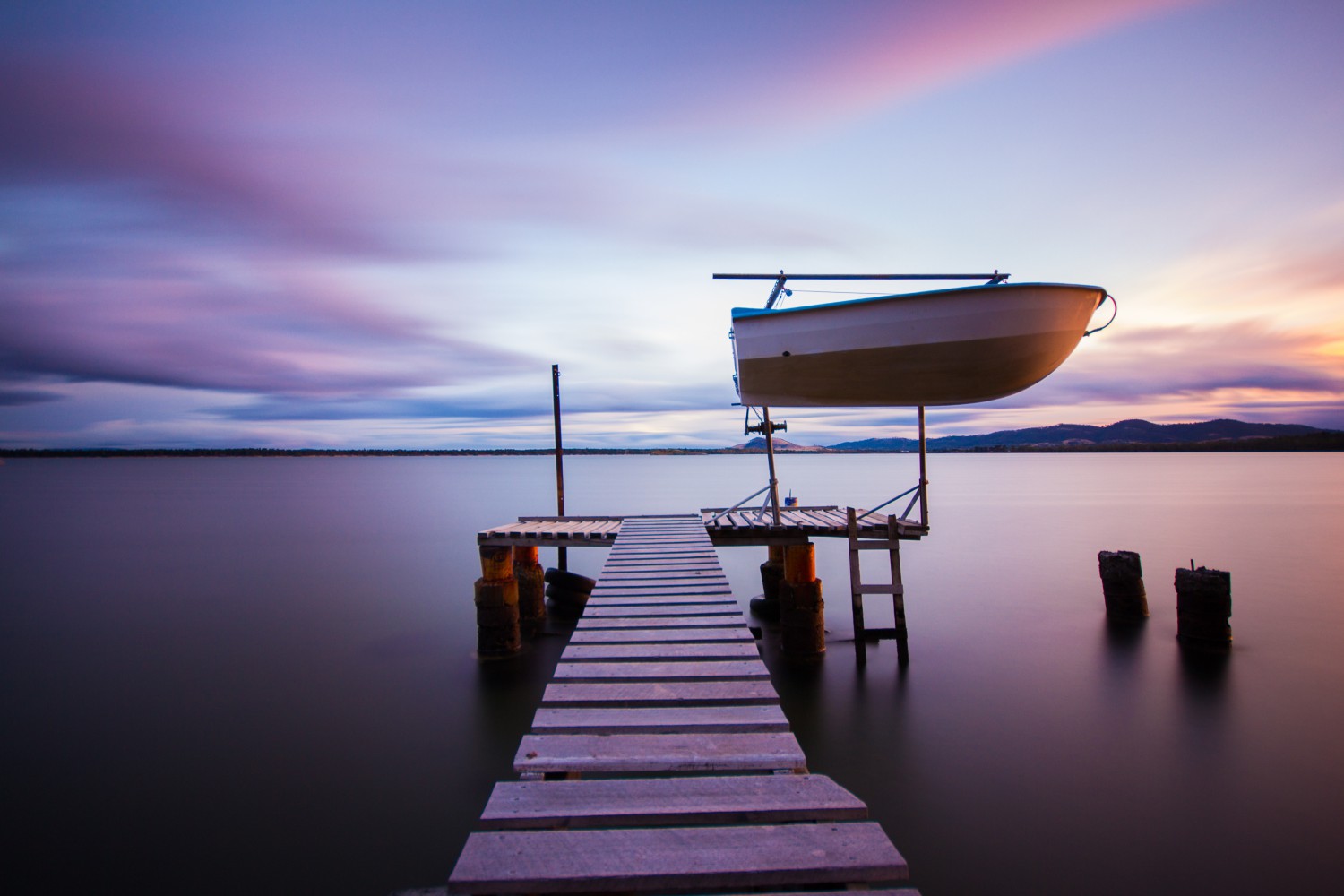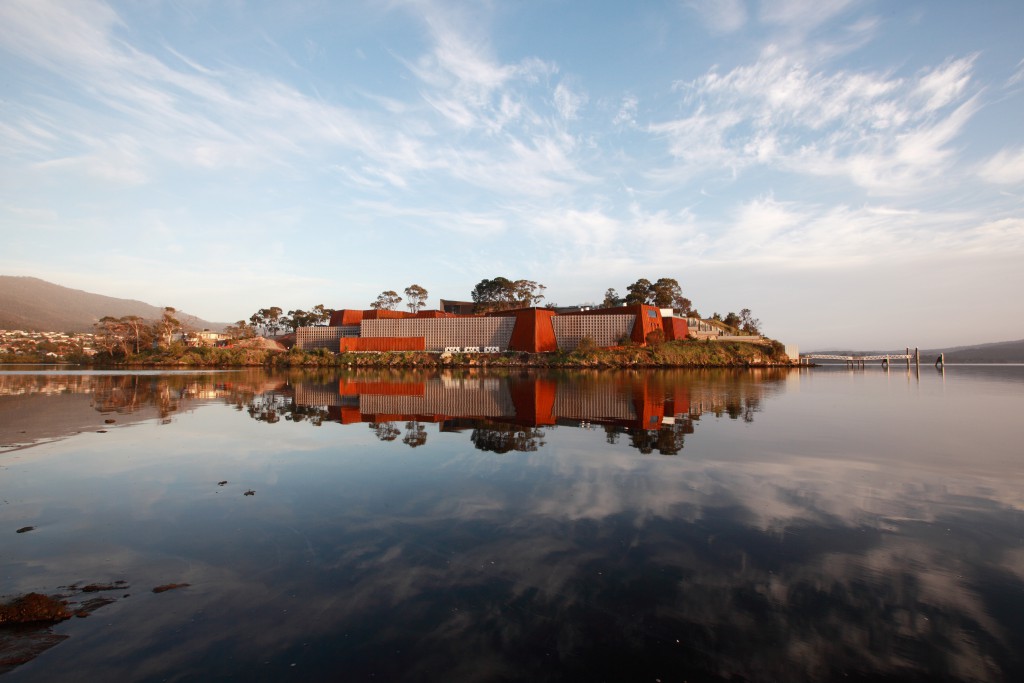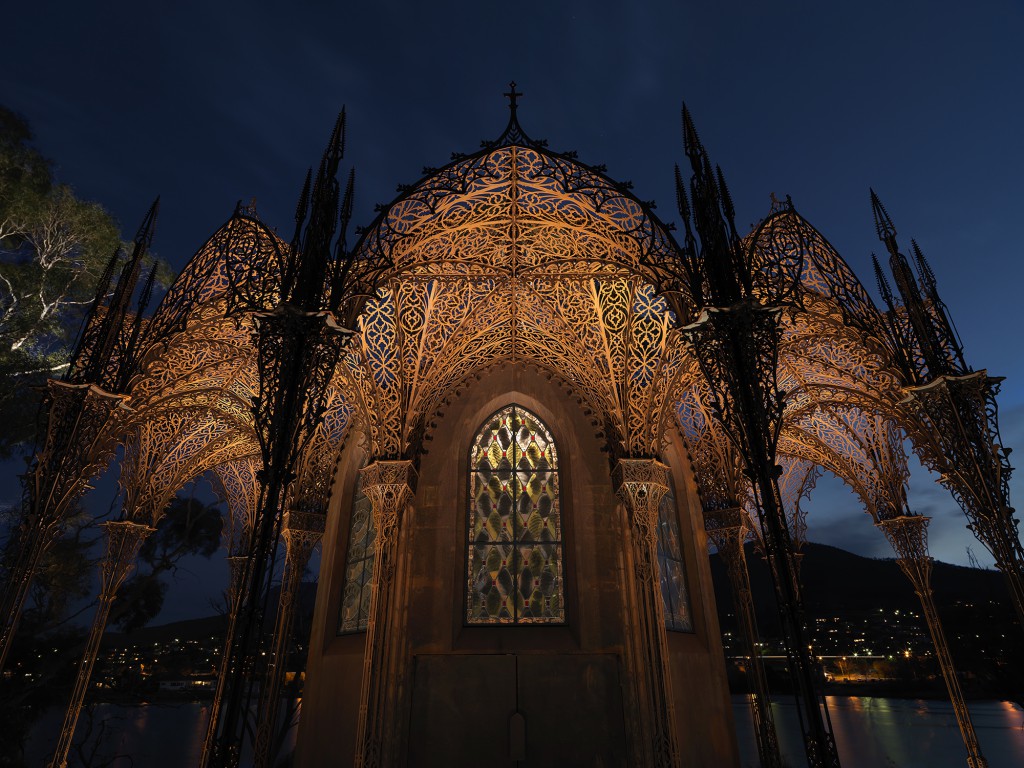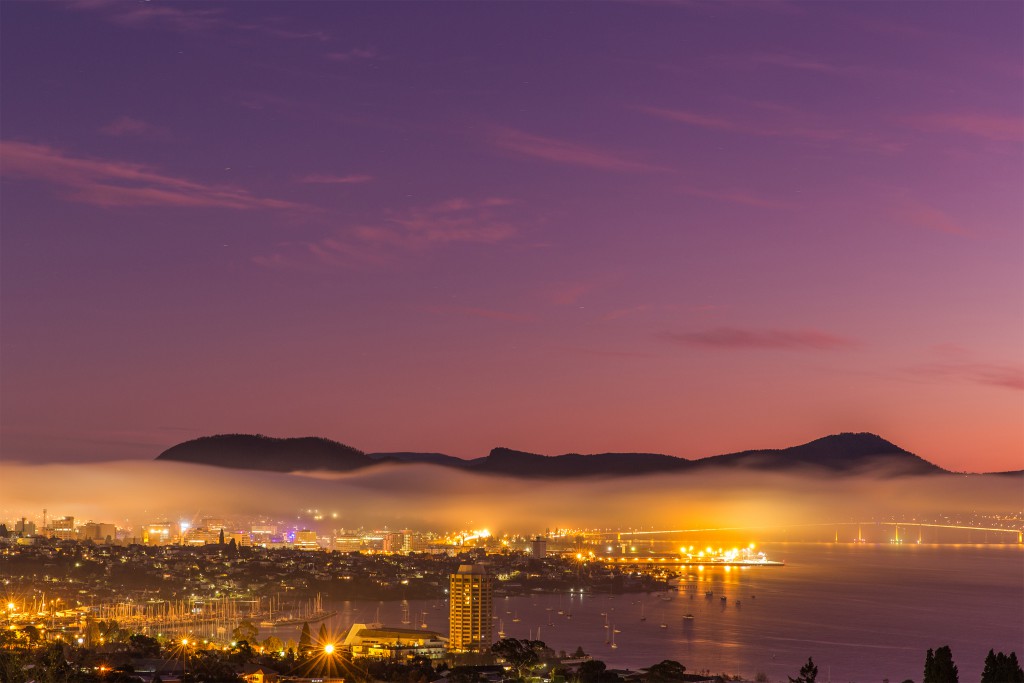Hobart: Centre of Food, Wine and Art
I land in Hobart bright and early, the thick blanket of cloud giving way to one of dense green vegetation before the peninsula city itself comes into view. Once on the ground, I check in at the Salamanca Wharf Hotel, a sympathetic new build among the surrounding historic sandstone warehouse structures. It is still early but the friendly staff happily relieve me of my bags, and I set off on my first local adventure. The Museum of Old and New Art (MONA) has loomed large over Hobart’s, and indeed Australia’s artistic and cultural scene since its inception in 2011, and I am anxious to see just what that impact looks like up close.

As I enter the Brooke Street Pier where the ferry to MONA departs, along with my surprise at discovering that the pier itself is a barge — floating on the water and rising and falling with the tides — I am struck by the volume and variety of local produce on display, from salmon, cheese, and various brewed and fermented beverages to crafts and soaps. With both ferry and museum entry ticket in hand thanks to the helpful MONA staff, I browse leisurely before heading down to board the boat. After a cruise-by tour of Hobart, in no time we are disembarking at the museum site. As I climb the 100 steps to the entrance, counting each one almost superstitiously, I look back and notice the distinctive camouflage exterior of the vessel — one of many touches that set the MONA experience out of the ordinary. I feel a small sense of achievement having completed my epic ascent of the steps, and along with the rest of the crowd enter excitedly into the museum itself.

I begin an ominous descent: down, down, down a spiral staircase to the ‘beginning’ of the exhibition space. Here I am introduced to my companion for my visit: the ‘O’, MONA’s iPhone-style interpretive device, which uses positioning technology to replace traditional wall labels with summaries, ‘art wanks’, comment from museum founder and benefactor David Walsh, and audio material relevant to works in the vicinity as one moves through the exhibition spaces. It’s highly intuitive, and in many cases a lot more fun than conventional labelling: the comment on an untitled work by Jannis Kounellis featuring two small goldfish swimming in a white bowl, accompanied by the menacing yet inert presence of a large, sharp knife? “Poor little bastards.” This is emblematic of the MONA experience: being a private museum, the work can and does push boundaries, creating extreme responses (another major feature of the O is the ability to vote ‘Love’ or ‘Hate’ in relation to each piece), but it almost always evinces a dark sense of humour on the part of artist, patron, and indeed, visitor.

As I make my way up through the galleries, I find myself in line for the ‘death room’, where entry is restricted to two at a time. Eventually my turn arrives and I head in alone. It is ‘deathly quiet’ in here, I think to myself — a morbid pun that suggests the MONA sensibility must be rubbing off on me — save for the drip, drip, drip of water, somewhere in the corner of the room. I pick my way carefully along a pathway of white stones surrounded by an inky pool and approach the casket of the mummy of Pausiris — one of several ancient artefacts, the ‘old’ art, in this museum. The real Pausiris, to my left, is rivalled by a digital representation to my right which slowly reveals the interior of the casket, piercing through wrappings and tissue and down to bones. Pausiris is accompanied by a close-up posthumous portrait by Andres Serrano, more beautiful than shocking, and all the more affecting for it. I take a deep breath, soak in this sacred space, and head back out into the real world — up the spiral staircase and out into the (very) fresh air.
Suffering ever so slightly from museum fatigue, on my return I am pleasantly surprised to find my luggage has already magically made its way to my loft penthouse at the Salamanca Wharf Hotel. Along with custom furniture formed from Tasmanian timbers, the suite features Antarctic photography by adventurer Laurent Dick — a nod to Hobart’s relatively sizeable population of polar and ocean scientists who use the city as a gateway to the frozen continent. With the climate outside seemingly attempting to match that of its southern counterpart, I draw a bath in the deep tub and settle in for a cosy evening at home.

The next morning I survey my temporary kingdom from the apartment’s wide balcony, with the Salamanca precinct on one side and the harbour on the other. However, I have little opportunity to pause: I am to begin my exploration of Hobart city with Gourmania Food Tours. We meet at the Tassal Salmon Shop, just down the street in Salamanca Square, and we do not waste any time getting down to business. Before I know it, I am seated in front of a plate of gravlax, and cold and hot smoked salmon. As we work our way through, tasting the substantial differences between the varieties, we learn about the processes involved in their creation, and also the salmon’s origin. This is a major industry for Tasmania, with the imported Atlantic salmon doing particularly well here due to the mix of fresh and sea water available in the region.
As we traverse the city, we sample incredible wares at the Hobart outpost of Bruny Island Cheese, learn about the area’s cool climate wines at the appropriately-named Cool Wine store, are overwhelmed by the selection of smallgoods at Wursthaus Kitchen, and have a memorable encounter with the harbour’s resident seal, Sammy, as we enjoy fish and chips by the water. The day is punctuated by discussions with each producer about the specificities of the local environment and the ways in which this affects the final product. For example, I am fascinated by the existence of saltgrass lamb, whereby sea salt is whipped up from the surrounding ocean by the area’s infamous winds, to be deposited on each blade of grass on nearby Flinders Island, whence it makes its way into the cutlets before us.
Undoubtedly one of the benefits of experiencing the tour with Mary is not only the high quality local produce we’re able to discover, but the inside knowledge she carries with her as a long-time local in the food industry herself. She points out the recurring characters at the Retro Café, a Hobart institution where most food workers have done a stint, and recounts her own time cooking at Jackman & Mcross, and Smolt, two highlights of the tour: the former offering tasty baked treats and great coffee, the latter spoiling us with a selection of such original ice-cream flavours that it is difficult to pick just one. In these ways, we are able to gain an appreciation not just for the products, but of the people behind them.
This theme is continued over the course of my next appointment, with Christine from HobART Walks. Christine arrives as we are wrapping up at Smolt, and it is no surprise to find she and Mary know each other — this seems to be that kind of town. We begin our art walk at the Salamanca Arts Centre, where, after checking out the wares at design store Oyster & Pearl, we take in a collaborative show by two emerging artists, Kate Piekutowski and Bethany van Rijswijk, before heading up to the studio of Adrian Barber. Adrian explains a little about his process — in addition to his larger-scale paintings, he is currently experimenting with combining smaller square panels in various ways, taking his cues from naturally-occurring patterns on wood and rocks in the local mountain landscape.
Next up are the dealer galleries — Handmark, Colville, and Despard — all within a short distance. Christine introduces me to the owners and staff of these establishments, and we discuss the work on show. Adrian has just splashed out on a pair of extremely fine porcelain bowls by Andrea Barker, and we admire these at Handmark. At Colville I am taken with the fascinating print work of Milan Milojevic, under whom Christine trained as a young artist.; I learn he was a major reason for her move to Hobart in the first place, decades ago now. The gallery’s Director, Trudi Young, educates me on the fantastic ‘Collect’ scheme, which provides interest-free loans for people to purchase Tasmanian art. Perhaps one of Milan’s pieces is not so out of reach after all.
As we stroll past the Hothouse, a temporary bamboo structure-in-progress which is to be a venue for the upcoming Dark Mofo winter festival, we discuss MONA’s influence on the Hobart cultural scene. Christine explains the way in which Dark Mofo is intended to get people out and about during a season when they would otherwise be tucked away in their homes; the intention is to bring light and warmth to a dark, and often bitterly cold time of year, and in so doing, to create a sense of community that can be easily lost when people are isolated.
Arriving on the other side of the port, Christine shows me around her old stomping ground, the Tasmanian College of the Arts. A highlight of the day, the school is housed in an old jam factory. As we walk through, running into established Tasmanian artists here and there, I notice it retains remnants of its former life in the form of exposed beams, pulley tracks along the ceilings, and curious doors to nowhere. However, strongest is the impression left by the open workspaces with large arched windows that look out onto the bay — these are some very fortunate art students. Beyond the calibre of teachers to whom they have access, it is easy to see why they choose to develop their craft here.
Our final stop is the exclusive Henry Jones Art Hotel, where Christine undertakes her day job as curator of the establishment’s extensive art collection. We wander the halls, and Christine explains her curatorial process, along with the processes and significance of each of the featured artists. As I race back across the docks in the rain toward the beacon of twinkling lights adorning the trees along the esplanade, in conjunction with my longing to get ‘home’ for the night it strikes me how familiar I am feeling with the area already. Safely ensconced back in the apartment, I make use of its full kitchen to construct a simple dinner, keeping in mind that I have another epicurean extravaganza awaiting me in the morning.
Before 8am, I am collected by Nicole, the outgoing and knowledgeable guide for Pennicott Wilderness Journeys’ ‘Bruny Island Traveller’ tour. We take the scenic route to the ferry terminal at Kettering, driving through the streets of historic Battery Point and out past the casino where David Walsh, somewhat of a mathematical genius, made his fortune counting cards. Along the way we talk house prices — with waterfront properties close to the city going for an absolute steal compared to the mainland, I can certainly see the appeal for those who choose to settle here.

Once on the island after the scenic ferry crossing, our first stop is the Bruny Island Cheese Company. Having tasted their artisan cheeses the previous day, I am excited to see where the magic happens. We are set up inside by the fire with a view to the cheese storage rooms, and work through several delicious varieties accompanied with almost equally impressive fresh wood-fired bread, made in an oven right outside. Though it is hard to tear ourselves away, we are on a mission. Next stop is Get Shucked, Bruny’s oyster farm. I am not usually a huge shellfish fan, but I have resolved that this is the day I will give oysters a try. Fortunately there is another member of our party in the same boat, so I am not alone in my inexperience. We approach the laden plate with trepidation, and are rewarded for our bravery with mouthfuls of briny-in-a-good-way freshness — it is the taste of the ocean that we spy just outside.
Once we’ve had our fill, it is on to Adventure Bay, one of the island’s main townships which fills to the brim during holiday periods, and the base for Pennicott’s boating operations. We are not left without a morsel for long; here we enjoy a freshly-baked muffin with a hot drink before taking a walk on the expansive beach. However, the main attraction is the population of rare white wallabies who have run of a former beachside campground, now maintained by the tour company as a reserve of sorts. We inch along in the van, keenly looking out for any sign of the elusive creatures. We are not disappointed: they soon pop their unmistakable snowy heads out of the brush. We get out of the van and creep as close as possible before they bound away.
Before the day is over, I will enjoy a fantastic pinot noir with a memorable lamb lunch — again by the fire — at Bruny Island Premium Wines, followed by a sugar overload at Hiba’s very cute fudge and chocolate store, topped off by a warming liqueur at the beautifully-situated House of Whiskey. All of this indulgence has to be worked off, so it is fortunate we have the opportunity to climb the many steps to the lookout over the Neck, a sandbar that is the thinnest point of the island. As I’m refreshed by the whipping wind, I look out to sea and back across the land, and reflect on the abundance of local produce available on such a small, isolated island. Those who live here are close to self-sufficient, and despite the rugged landscape, this is starting to seem like a luxury rather than a hardship.
As I walk outside early the following morning to catch my ride back out to the airport, I pass stallholders setting up for the iconic Salamanca Market — a Hobart institution that I will unfortunately miss this time — and I can see the Hothouse has inched closer to the realisation of its designers’ vision over the last few days. Although my time getting to know this town is drawing to a close, life goes on for the lucky locals who get to stay, and I am glad I have had the chance to see what brings and keeps them here.
